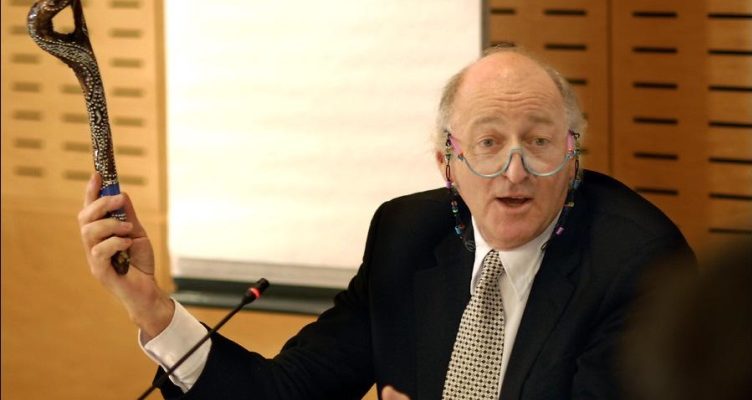Some years ago my wife, Dr. Rosemary Howell, saw an aboriginal speaking stick, 82 centimetres long, at an art gallery on the Queensland Gold Coast. She asked whether it might be possible to obtain a miniature and was told it was indeed possible, so long as she also bought the original. It took several days to find a smaller stick, 42½ centimetres long, with the requisite megaphone-like shape at one end. It was beautifully decorated by aboriginal artist Denise Waller and lacquered so that I can’t damage it. I have them both in my office. The full-size one is too big and heavy for me to lug around but the miniature fits neatly into my bag and I place it on the table in front of me when I mediate. Towards the end of my usual initial address to the parties, once we have introduced ourselves, I ask that two procedural rules be observed. The first is that while we are all in open session we kill all mobile ‘phones. (The only exception I have permitted was when someone said his wife was expecting a baby that day). The second has to do with the speaking stick, which I pass around the table as I explain that when the Bundjalung aboriginal community holds its meetings, they have a rule that, in order to speak, you have to be holding the speaking stick; and that the full-sized one is a pretty useful tool to enforce the rule. I tell those present they do not actually have to hold the stick but that I would like them to agree, at least notionally, to that rule.
It dawned on me recently that the stick performs much the same role as the Speaker’s parliamentary mace, and pre-dates that by several millennia.
Although some lawyers tend to sneer at it, when someone interrupts others often call for the stick as a reminder of the rule. Sometimes when I am leaving the room to go to a caucus, someone will suggest I take the stick with me. Hence I find the stick works not merely to keep order but also to generate a collaborative atmosphere.
I have taken my speaking stick to the ICC International Commercial Mediation Competition, an event held every February in Paris since 2006, with over 500 participants: in 2017 there were 66 universities or graduate schools from over 40 countries and 130 professional mediators or mediation trainers.
Last year Alain Roy, a renowned French mediator, roy.al@wanadoo.fr, commented as to why such a beautiful object can be so efficient in mediations. He has kindly allowed me to share his comments here:
“This speaking stick fulfils 5 functions in the mediation:
1 – A pragmatic function.
It allows to introduce the non-interruption rule at the beginning of the mediation: as he shows the stick to all, Alan explains that within this Australian aboriginal community, only the person holding the stick in his hands is allowed to speak, the others must listen. In practice and except in special cases, parties do not need to hold the stick to speak: if chaos would happen during the mediation, it is enough for the mediator to raise and show the stick to restore a listening behaviour.
2 – A symbolic function.
It transforms the meeting room into a mediation room: introducing such an unusual object shows clearly that a mediation is different from usual business meetings. In my own experience in work-place mediations, in cases when no outside meeting room was available, I sometimes tried to obtain the same effect by asking for a one-minute silence before starting the mediation.
3 – A physical energetical function.
The stick creates its own physical energy: having it pass from hand to hand allows each person to hold it physically, causing each one to make the mediation his own. It also creates a physical link between persons when one passes it to the other. In this way, the stick nourishes the physical dimension of the mediation.
4 – A spiritual energetical function.
The stick installs in the room a positive spiritual energy: as the object is very beautiful (this is a mandatory requirement!), each one feels an artistical emotion when holding it and looking at it, and this spiritual positive emotion is shared by all in the room. It is art’s function to pull people upwards.
5 – A securing function.
The stick contributes to install the mediation security by creating a peaceful atmosphere: when showing that we take the time to honour the stick, we show that here in this room we will take the time to handle things as they deserve, whereas parties, very upset and full of chaos, had come to the mediation being tense and willing to fight. It installs calm and creates a secure frame for the mediation.”
To make sure you don’t miss out on regular updates from the Kluwer Mediation Blog, please subscribe here.
________________________
To make sure you do not miss out on regular updates from the Kluwer Mediation Blog, please subscribe here.



